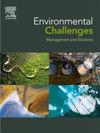Projected climate change impacts on streamflow in the Upper Oum Er Rbia Basin, Upstream of the Ahmed El Hansali Dam, Morocco
Q2 Environmental Science
引用次数: 0
Abstract
Climate change is reshaping water resource availability, with serious implications for regions dependent on stable dam supplies. This study explores the projected impacts of climate change on streamflow in Morocco's Upper Oum Er Rbia Basin, specifically assessing the implications for water supply to the Ahmed El Hansali Dam. Using the SWAT model, driven by climate data on precipitation and temperature sourced from five regional models in the Euro-CORDEX initiative under scenarios RCP 4.5 and RCP 8.5, future runoff was simulated across three critical timeframes: the near future (2025–2050), mid-century (2051–2075), and late century (2076–2100), with comparisons made to a historical baseline (1981–2010). Results reveal significant potential changes, with projections indicating declines in precipitation by 21% to 45% and temperature increases of 24% to 43% by 2100. These shifts are expected to reduce average river flows by 23% to 53%. Specifically, flow rates are projected to decline by 10–20% for the Oum Er Rbia, 25–48% for the Srou, and 38–49% for the Ouaoumana rivers, all vital contributors to the dam's reservoir. Consequently, the dam's annual water supply, historically around 720 hm³, could decrease by 118 to 288 hm³. Winter, the most crucial season for water supply to the dam, is expected to be particularly impacted, with flow reductions of 22–51%, equating to losses of 60 to 139 hm³. These findings underscore the need for adaptive water management strategies and highlight the urgency for climate-resilient planning measures, offering critical insights to support decision-makers in safeguarding water resources under changing climatic conditions.
气候变化对摩洛哥Ahmed El Hansali大坝上游上Oum Er Rbia盆地流量的预测影响
气候变化正在重塑水资源的可用性,对依赖稳定水坝供应的地区产生严重影响。本研究探讨了气候变化对摩洛哥上欧姆河流域水流的预期影响,具体评估了气候变化对Ahmed El Hansali大坝供水的影响。利用SWAT模式,在RCP 4.5和RCP 8.5情景下,由Euro-CORDEX倡议中五个区域模式的降水和温度气候数据驱动,模拟了三个关键时间框架内的未来径流:近期(2025-2050)、本世纪中叶(2051-2075)和世纪末(2076-2100),并与历史基线(1981-2010)进行了比较。结果显示了显著的潜在变化,预估表明到2100年降水量将减少21%至45%,温度将升高24%至43%。这些变化预计将使河流平均流量减少23%至53%。具体来说,乌姆鲁比亚河的流量预计将下降10-20%,Srou河下降25-48%,Ouaoumana河下降38-49%,这些河流都是大坝水库的重要贡献者。因此,大坝的年供水量,历史上约为720立方米,可能会减少118至288立方米。冬季是大坝供水最关键的季节,预计将受到特别影响,流量减少22-51%,相当于损失60至139 hm³。这些发现强调了适应性水资源管理战略的必要性,强调了气候适应型规划措施的紧迫性,为支持决策者在不断变化的气候条件下保护水资源提供了重要见解。
本文章由计算机程序翻译,如有差异,请以英文原文为准。
求助全文
约1分钟内获得全文
求助全文
来源期刊

Environmental Challenges
Environmental Science-Environmental Engineering
CiteScore
8.00
自引率
0.00%
发文量
249
审稿时长
8 weeks
 求助内容:
求助内容: 应助结果提醒方式:
应助结果提醒方式:


